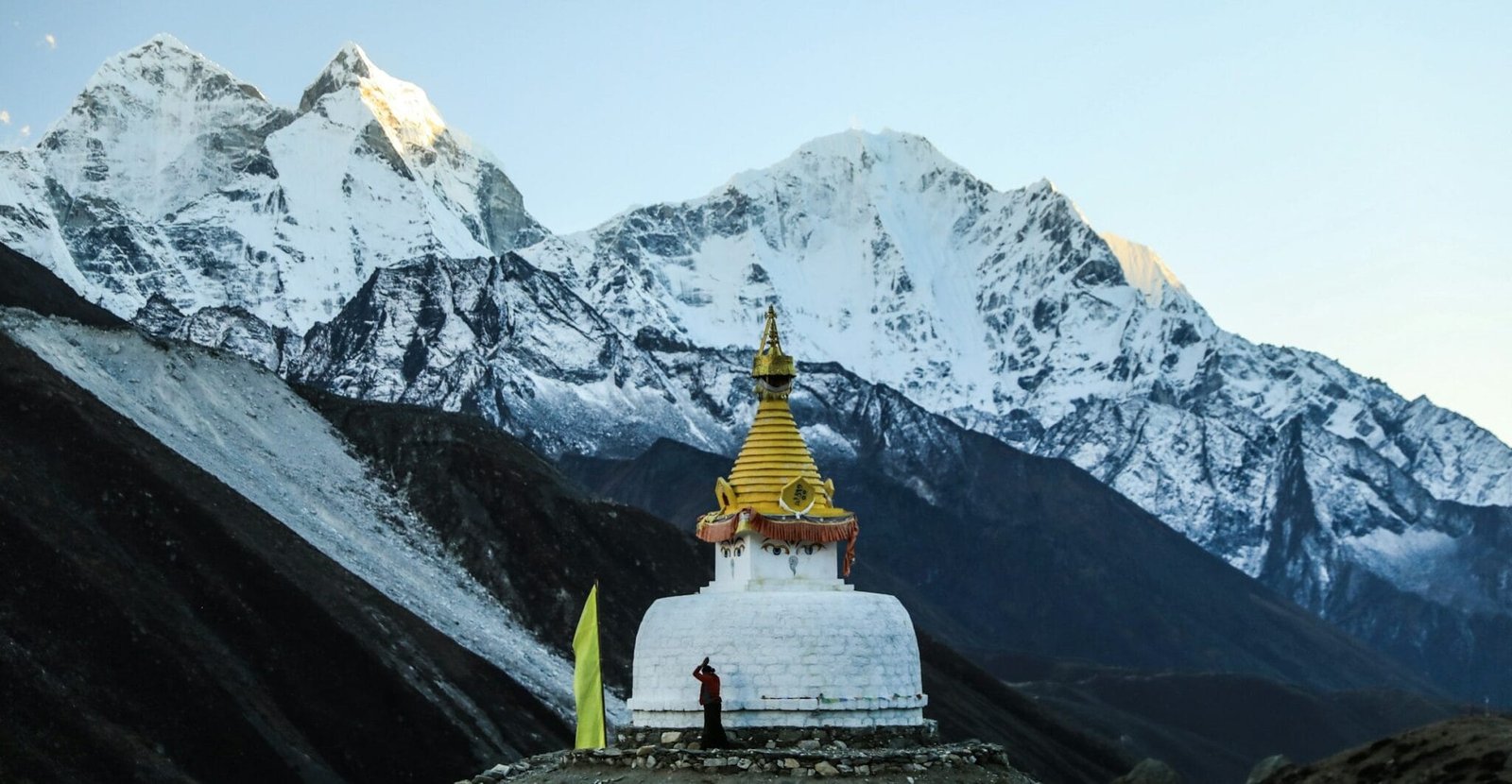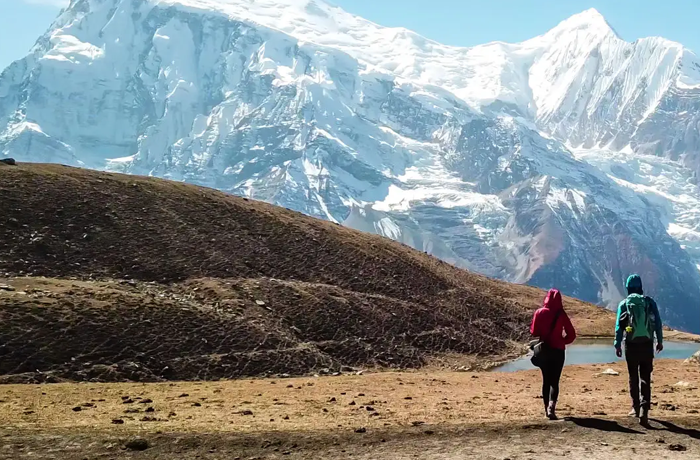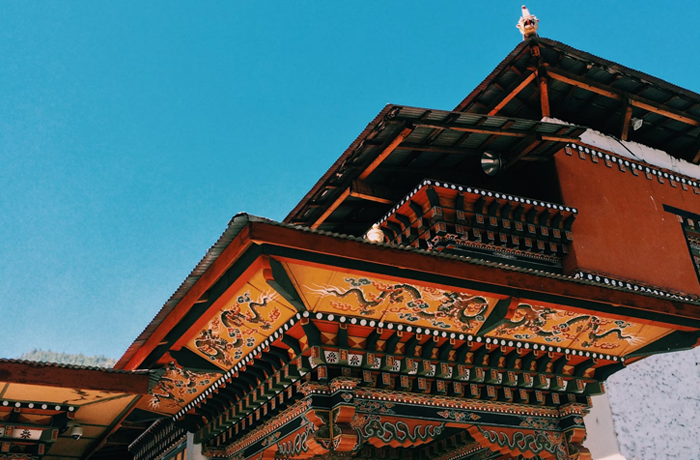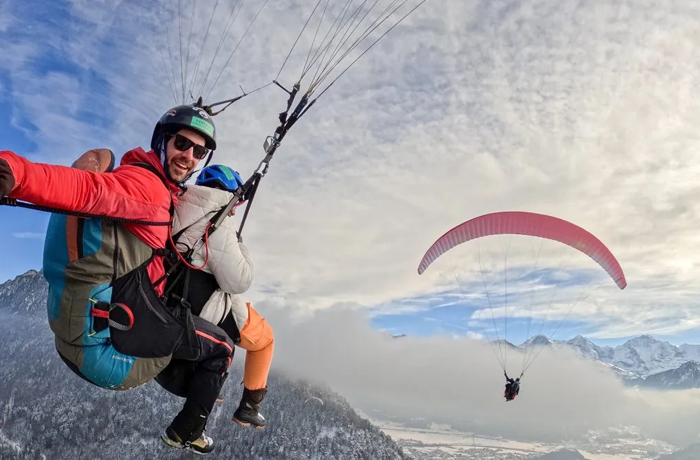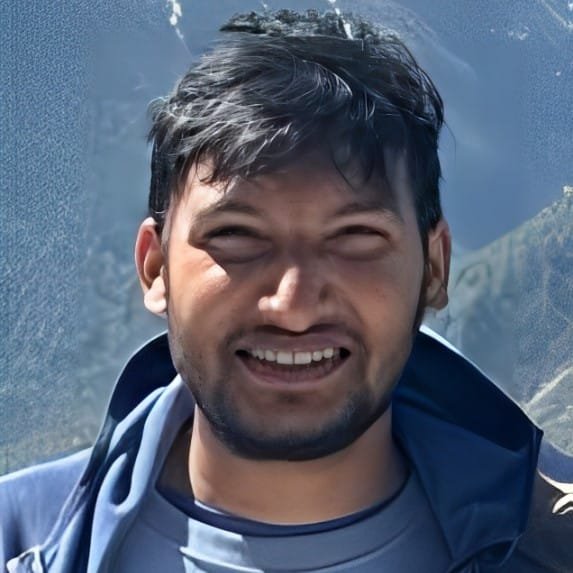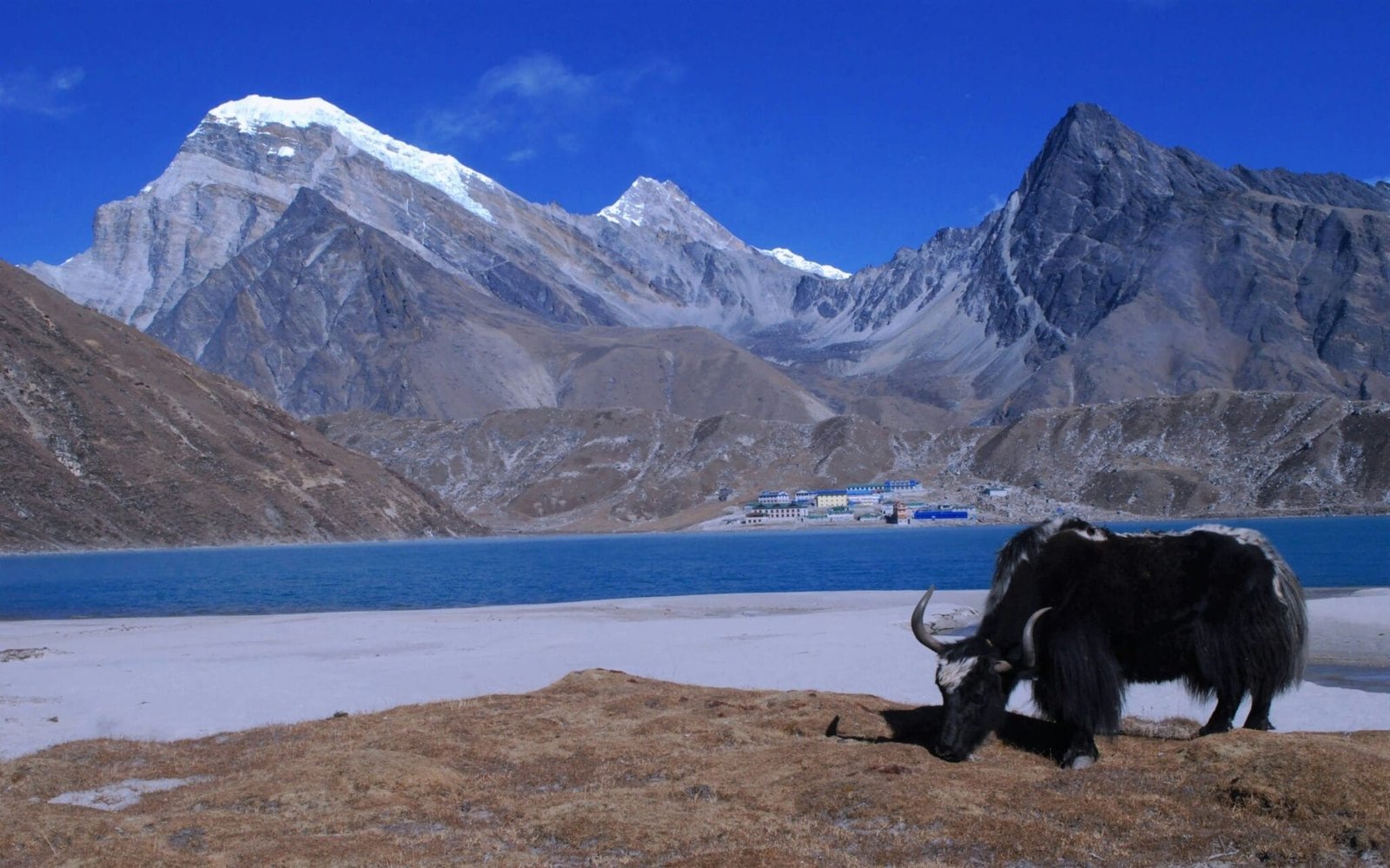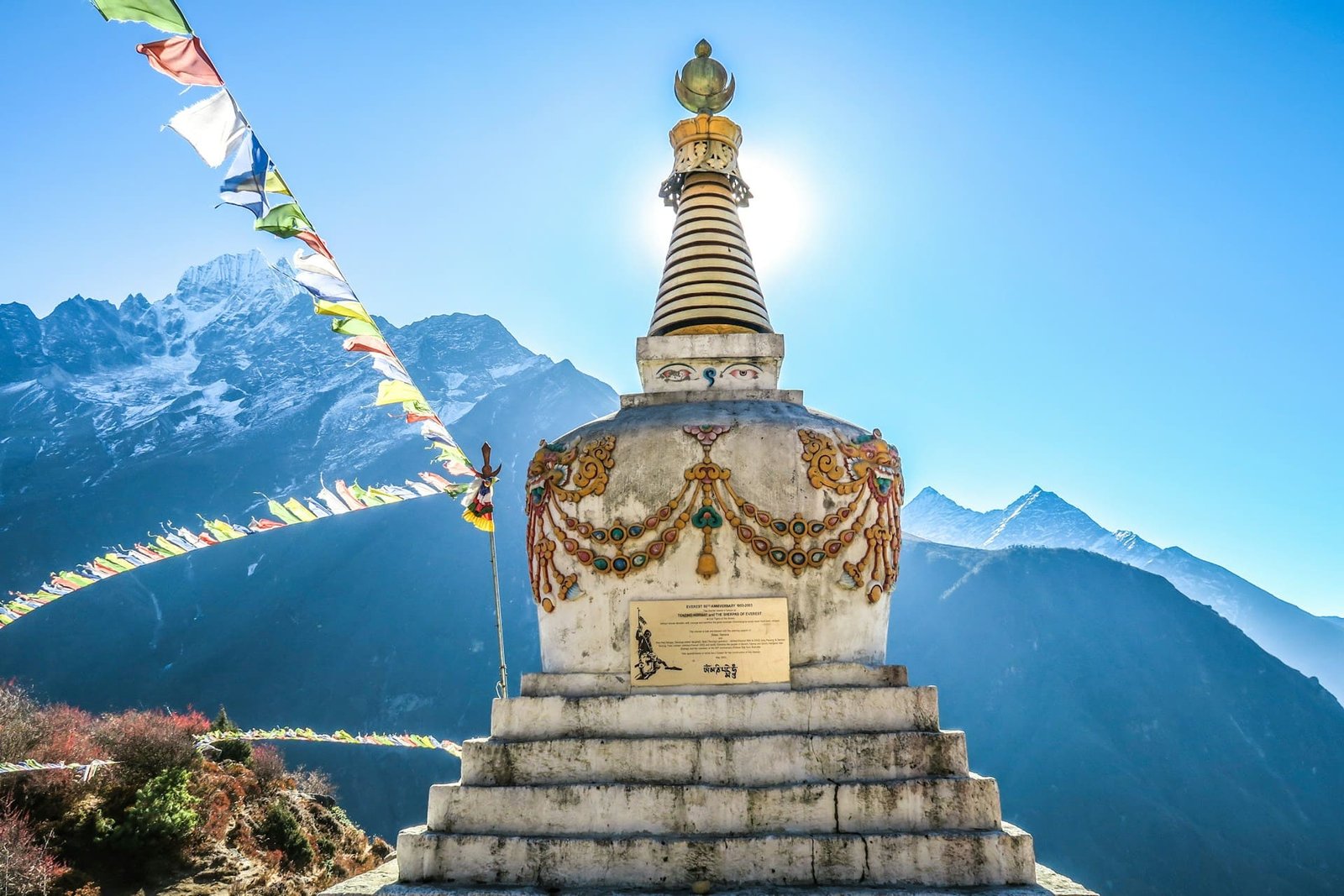Everest Base Camp Trek 15 Days
Lukla Flight Information
You have the chance to take an exciting flight from Kathmandu to Lukla as part of the trek to Everest Base Camp Trek. A flight from Kathmandu to the Tenzing-Hillary airport in Lukla is the first leg of almost every trek in Nepal.
It takes about 35 minutes to fly from Kathmandu to Lukla. One of the world’s smallest runways is located at Lukla. The flight itself is quite adventurous and completely safe. Even so, the trip to Lukla might still be unsettling.
All should know that during the busiest trekking seasons, flights from Tribhuvan International Airport to Lukla could be diverted to Manthali Airport because of heavy traffic. From Kathmandu, it will take four hours by road.
Lukla can be reached by plane from Manthali in twenty minutes. Lukla flight delays are a regular occurrence. When it comes to weather, the airlines never take a chance. The primary factors affecting the flying schedule are the erratic weather and low visibility.
Among the airlines that frequently run service from Kathmandu/Manthali to Lukla are:
- Tara Air
- Summit Air
- Sita Air
You can arrange for a helicopter to Lukla if you’d rather not make the journey from Kathmandu to Manthali. But the additional cost will be about USD 550 per person.
Trip Duration
15 Days
Country
Nepal
Region
Everest
Activities
Trekking / Hiking
Grade
Moderate
Max Altitude
5644m
Best Season
Autumn and Spring
Accomodation
Hotel and Tea House
Meals
Breakfast, Lunch, and Dinner
Start-End Point
Kathmandu-Kathmandu
Group Size
1-50 Pax

Transportation
Flight / Private vehicle / Public vehicles
Everest Base Camp Trek 15 Days Overview
Best Trek and Adventure presents the classic Everest Base Camp Trek revealing the beauty of the Himalayas of Nepal. The journey to the base camp provides you with an adventure like never before.
The trek to Everest Base Camp Trek (EBC Trek) usually takes around 15 days through the mountain landscape include a day Kathmandu Valley UNESCO World Heritage Sites Tour. Lukla being the starting point of the trek in the Everest region is reached via scenic flight from Kathmandu/Manthali to Lukla airport.
As the trek initiates, you come across the Sagarmatha National Park while passing through dense forests, pristine rivers, green hills, waterfalls, glaciers, and many more. On top of that, the Sherpa villages like Namche, Tengboche, Dingboche, and more expose you to unique Sherpa culture and their way of life.
As the name of the trek suggests, you are sure to be captivated by the world’s highest mountain, Mt Everest. Besides Everest, the majestic views of Ama Dablam, Lhotse, Nuptse, Lobuche, etc. are out of this world.
Moreover, visiting ancient monasteries, witnessing mountain vistas from Kala Patthar, and seeing major landmarks like Khumbu Glacier up close are the major highlights of the trek.
As for the trekking difficulty, the Everest Base Camp Trek (EBC Trek) is considered moderately difficult. However, trekkers need to be physically fit since one needs to trek above 5,000 meters in altitude. So, it’s best to prepare for the trek, especially for beginners.
In addition, the trekking experience can greatly vary in choosing the best time. To make your journey accomplishable, spring and autumn are the seasons that are preferred the most due to the fair weather and temperature.
So come join us today! We strive to make every trekking experience a positive one and hope to make it meaningful to Everest Base Camp Trek.
If you are planning to visit and want to do life-time memorable trip to Nepal feel free to contact us for your trip to Everest Base Camp Trek.
Everest Base Camp Trek Highlights
- Venture on a trek to Everest Base Camp, the base of the stunning Mount Everest.
- Watch the sunset over Everest from Kalapatthar, often known as the Everest viewpoint.
- Enjoy the Buddhist community's distinct and historic lifestyle.
- Explore Tengboche Monastery, the largest monastery in the Khumbu region.
- Enjoy a glimpse of the Khumbu glacier and icefall.
- Stunning views of Mt. Everest, Ama Dablam, Lhotse, Nuptse, Thamserku, Cho Oyu, and many other peaks.
- Use those important acclimatization days to learn about the Sherpa's lifestyle.
- Pass through Sagarmatha National Park, featuring distinct vegetation and fauna.
- Museums, libraries, and workshops (e.g., Sherpa Culture Museum, Khumbu International Library, Pyramid International Laboratory)
- Highland monasteries decorated with colorful prayer flags, mani walls, and prayer wheels provide a spiritual experience.
Brief itinerary
Day 1: Arrive in Kathmandu hotel from Tribhuvan International Airport. (1350 m)
Day 2: Kathmandu Valley 4 UNESCO World Heritage Sites Tour (1350 m)
Day 3: Flight from Kathmandu or Ramechhap to Lukla (35 minutes) and hike to Monjo (2710 m)
Day 4: Monjo to Namche Bazar (3440 m)
Day 5: Acclimatization day in Namche Bazar (3440 m).
Day 6: Namche to Tengboche (3860 m)
Day 7: Tengboche to Dingboche (4410 m)
Day 8: Dingboche to Lobuche (4910 m)
Day 9: Lobuche to Gorak Shep (5130 m)
Day 10: Gorakshep to Kala Patthar (5545 m / 18192 ft)
Day 11: Gorakshep to Pheriche (4370 m)
Day 12: Pheriche to Namche Bazar (3440 m)
Day 13: Namche to Lukla (2830 m)
Day 14: Fly from Lukla to Kathmandu and Transfer to Hotel (1350 m)
Day 15: Final Departure
Detailed Itinerary
Expand AllUpon your arrival at Tribhuvan International Airport in Kathmandu, one of our staff will kindly accompany you from airport to hotel. You will have the opportunity to meet with your guide today and ask any additional inquiries regarding your journey to Everest Base Camp. Overnight at hotel in Kathmandu
Trek Distance:
6km
Max Altitude:
1350m
Duration:
30 Minutes
Accommodation:
3 star hotel
Meals:
Breakfast
The second day is spent witnessing the Kathmandu Valley and preparing for the Everest Base Camp Trek. Your guide will arrive after breakfast, so get ready for the journey. On this day, you will tour UNESCO Heritage Sites.
After a filling breakfast, you will be accompanied to some of Kathmandu’s most famous attractions, including, Swyambhunath Stupa, Patan Durbar Square, Pashupatinath Temple, and Boudhanath Stupa.
The first place you visit is Swayambhunath, a sacred stupa structure on a hill. From above, you can view the entire city of Kathmandu. Afterward, you’ll travel to Patan Durbar Square, which is situated in the heart of Lalitpur. Although the Krishna Mandir is its main feature, people are drawn to the lovely architecture.
From here, you get on a drive to the Pashupatinath Temple, a Hindu sacred site. Lord Shiva devotees flock to this temple on a daily basis. Following that, you will proceed to Boudhanath, Nepal’s largest stupa and a holy site for Buddhists. As you enter the structure, you will feel a sense of tranquility and calm.
Trek Distance:
25km drive
Max Altitude:
Kathmandu (1400m)
Duration:
5-7 hours
Accommodation:
3 star hotel
Meals:
Breakfast.
The journey to Lukla normally takes off in the morning, which is also safer because you’ll be flying above jagged cliffs and a diverse landscape. We prefer and recommend morning flights because they avoid the severe wind and the weather is clearer.
After landing in Lukla and taking some time to rest, you’ll go to Monjo across the Dudh Koshi River and a suspension bridge. On the way, you’ll see chortens, mani stones, and prayer flags.
On the first day of the trial, you will begin to see spectacular mountains such as Karyolung, Nupla, and Gongla. You will pause at many breaks for tea or lunch. You will spend the night in Monjo.
Max Altitude:
Lukla (2,830m)
Duration:
Flight Duration: 35 min /Trek Duration: 3 hrs
Accommodation:
Teahouse
Meals:
Breakfast, Lunch, Dinner
Following breakfast, you follow the trail along the Dudh Koshi River, crossing suspension bridges along the way. The trekking trail leads you through dense forests of rhododendrons, colossal firs, and magnolia trees. Soon enough you will arrive at Namche.
You can travel through Namche Bazar’s small lanes, speak with the people, visit several monasteries, Sherpa settlements, and local eateries, and take photographs of this charming town. You’ll be compelled to forget all your tiredness. You’ll spend a night at Namche Bazaar.
Max Altitude:
Namche (3,440m)
Duration:
7 hrs
Meals:
Breakfast, Lunch, Dinner
Altitude sickness and other serious health problems can occur while trekking at higher levels. That is why acclimating to the rising height is critical. Namche Bazaar is where the trek’s first acclimatization day will take place.
During acclimatization, you do not rest but instead go on short treks or roam around to help your body adjust to the new environment. As part of the itinerary, you’ll take a visit to Everest View Hotel. Moreover, you explore a few destinations such as Hilary School and Syangboche Airport.
In the evening, you can have a relaxing time at your teahouse and get ready for the next day.
Max Altitude:
3880 m
Duration:
3-4 hrs
Meals:
Breakfast, Lunch, Dinner
After breakfast, you will begin your journey to Tengboche, a stunning Khumjung town with the largest gompa (gumba). The magnificent trail continues from above the Dudh Koshi. From here, you can see the stunning views of the Khumbu region’s mountains, including Mt Everest, Nuptse, Ama Dablam, and Lhotse.
The trail to Tengboche is dusty with climbs, but the stunning vistas from the monastery make it all worthwhile.
Max Altitude:
Tengboche (3,860m)
Duration:
5 hrs
Meals:
Breakfast, Lunch, Dinner
After spending the night in Tengboche, you leave for Dingboche in the morning. The trip continues to Deboche through the alpine forest, crossing Imja Khola over a suspension bridge.
On the way, you come across a stone-inscribed wall. Hereafter, you begin your climb to Dingboche with stunning views of the surrounding mountains. As the trek advances, you can view barley, buckwheat, and potato fields along the way. You can wander the village and sip a hot cup of coffee or local tea.
Max Altitude:
Dingboche (4,410m)
Duration:
5 hrs
Meals:
Breakfast, Lunch, Dinner
On this day, you depart for Lobuche over a modest ascent to Thukla. From here, the magnificent scene of Taboche and Cholatse will take your breath away. You continue on, passing via the Khumbu Glacier’s lateral moraine and the Thukla Pass stone memorials.
After crossing the suspension bridge to Thukla, a difficult climb leads to the Lobuche pass. You’ll witness several colorful prayer flags, the Khagan Chorten, and a cemetery with hundreds of cairn memorials for those who died on the mountain.
Lobuche also provides beautiful mountain vistas. There is also a high altitude research center that can assist with communication during the rescue effort.
Max Altitude:
Lobuche (4,910m)
Duration:
5 hrs
Meals:
Breakfast, Lunch, Dinner
Today, there are two sections of the Everest Base Camp Trek. The trail first leads to Gorak Shep before continuing on to Everest Base Camp.
After breakfast, you leave Lobuche and hike down the Khumbu glacier, admiring the wonderful view of Mt. Nuptse. You soon arrive at the town of Gorak Shep. Gorak Shep was Mt. Everest’s original base camp, located at an elevation of 5130 meters. The trail is rocky, with views of snowy peaks, glaciers, and icebergs. You eventually end up at Everest Base Camp.
The magnificent and incredible view is an added bonus on your journey to the Everest Base Camp Trek. After spending some time here, you will return to Gorakshep and spend the night in a teahouse.
Max Altitude:
Everest Base Camp (5,364m/17,594ft)
Duration:
8 hrs
Meals:
Breakfast, Lunch, Dinner
Today you will ascend to Kala Patthar, the highest point on the Everest Base Camp Trek. The journey begins early in the morning with a stunning dawn view of the enormous mountains.
Kala Patthar provides a fantastic lookout point for stunning views of Lhotse, Nuptse, Pumori, and Mount Everest. After you have had your fill of seeing the mountains, you will return to Gorak Shep.
Max Altitude:
Kala Patthar (5,644 m)
Duration:
7 hrs
Meals:
Breakfast, Lunch, Dinner
The trek duration will be about 6 hours and you reach Pheriche to spend the night at a tea house. Pheriche is another stunning valley encircled by rugged hills and mountains.
Max Altitude:
Pheriche (4370 m)
Duration:
6 hrs
Meals:
Breakfast, Lunch, Dinner
After a hearty breakfast, you hike down to Namche, following the trail that you took before. As the hike advances, you pass via Pangboche settlement, then Tengboche village.
You will cross the suspension bridge again and continue through rhododendron and pine forests. Afterward, you will be greeted by spectacular mountain landscapes. The trail continues by passing several Mani stones, Chortens, and Stupas. Then you’ll arrive in Namche Bazaar and spend the rest of the night.
Max Altitude:
Namche (3,440m)
Duration:
7 hrs
Meals:
Breakfast, Lunch, Dinner
The thrill of hiking Everest Base Camp finishes today once you arrive at Lukla. You depart Namche Bazaar for Lukla after breakfast. Take a trip around the village on your last day in the Everest region.
On the last day of the journey, you will follow a steep rocky track across the terrain and pass multiple suspension bridges over the Dudh Koshi River. The bridges connect stunning rhododendron and pine forests, as well as magical Sherpa communities, before leading you to Lukla via trails. Walking the entire trail takes approximately 6-7 hours.
Max Altitude:
Lukla (2,830m)
Duration:
7 hrs
Meals:
Breakfast, Lunch, Dinner
This morning, we say farewell to Mt. Everest and the Khumbu Region as you catch the flight down to Kathmandu. Again, an emotional farewell to the magnificent mountains. Finally, you will arrive at Kathmandu Airport and be driven to your accommodation 3 star hotel in Kathmandu. Join for farewell dinner in typical Nepali restaurant with cultural program. Back to the hotel and overnight at hotel in Kathmandu.
Max Altitude:
Kathmandu (1,350m)
Duration:
Flight Duration: 30-45 min
Accommodation:
3 star hotel.
Meals:
Breakfast and Dinner
Today is your last day of the splendid journey to the Everest Base camp. If you have more time, you can again plan another visit with us. We are forever there to assist you and guide you. As per your flight schedule, you can check out of the hotel after/before breakfast to catch your booked flight to the airport. Time to say Good bye and see you soon for next trip to Nepal.
Trek Distance:
5km
Max Altitude:
1350m
Duration:
30 minutes
Meals:
Breakfast
Everest Base Camp Trek 15 Days Includes/Exclude
- Arrival from Airport to hotel.
- 3 star category accommodation in Kathmandu days.
- All ground transports as per itinerary.
- Flight tickets from Kathmandu/ Ramechhap to Lukla and return.
- Full board meals with tea/coffee (Breakfast, Lunch, and dinner) during the trek days.
- Bed and breakfast in Kathmandu days.
- One highly experienced, helpful, and friendly guide, porters (1 porter for 2 people), and their food, accommodation, salary, equipment, and accidental insurance for all staff
- Best available twin sharing lodge to lodge (Tea house) accommodation during the trek
- First aid medical kit.
- Sagarmatha National Park Permits fee.
- Local government tax in Sagarmatha National Park.
- Government taxes and office service charge
- Farewell dinner with cultural show.
- Departure to the airport.
- International Flight tickets.
- Meals not specified in the 'Meal Inclusions' in the itinerary.'
- Travel Insurance
- Lunch and Dinner in Kathmandu Days.
- Nepal entry visa: you can obtain a visa easily upon your arrival at Tribhuwan International Airport in Kathmandu. (a multiple-entry tourist visa good for 30 days can be obtained by paying US $ 40 or equivalent foreign currency. Similarly, multiple-entry tourist visas for 90 days can be obtained by paying US $ 100. Please bring 2 copies of passport-size photos.)
- Cold Drinks Inc. coke, water, Fanta, etc.
- Snacks and other personal expenses
- Hot showers and internet during the trek except for Phakding, Namche, and Lukla
- Personal trekking equipment
- Any unexpected situation.
- Tips to guide and porter.
Everest Base Camp Trek Route Map
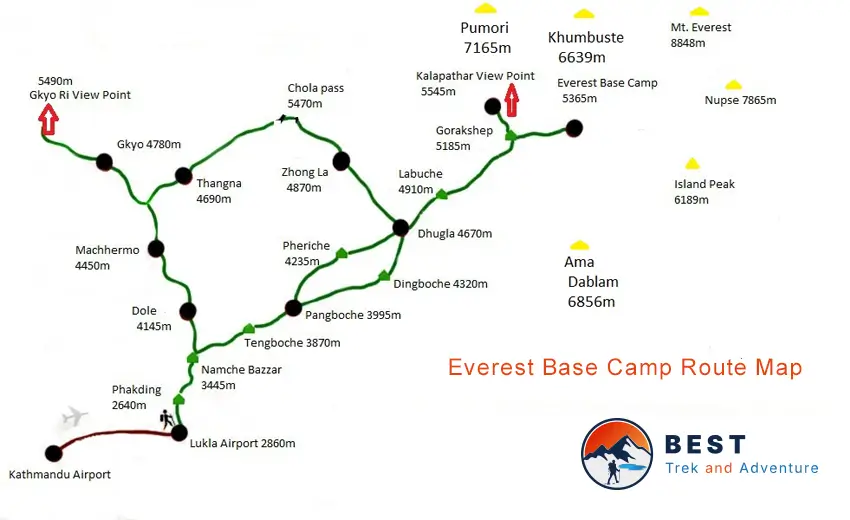
Everest Base Camp Trek 15 Days Altitude Chart
Best Time
Spring Season (March-May)
Spring is considered the most ideal season to trek to Everest Base Camp. In the spring, the weather is rather stable and ideal for high-altitude climbing.
Aside from the pleasant weather, the appealing views with a bright sky and beautiful rhododendrons along the walk are unquestionably positive. However, the best season with ideal weather comes at a cost. Because it is the peak season, the region becomes rather busy.
Most Everest summits take place during these months, so expect to see a lot of climbers, summiteers, and support teams!
If you trek during this time of year, you will also see spring floral displays. Blossoms full of crimson and pink rhododendrons have become synonymous with a spring EBC Trek. Everest Base Camp also comes alive in April and May, so if you want to experience the buzz and thrill of a fully working base camp, this is the time to visit.
Fall/Autumn Season (September – November)
After spring, the autumn season is an excellent time to trek to Everest Base Camp. The months of September to November also have moderate temperatures, bright skies, and a lower possibility of heavy rains or snowfall.
The temperature drops slightly in the fall compared to the spring. But it’s a fair exchange for the breathtaking vistas of the neighboring peaks that you get to enjoy during this season. In addition, you may receive mild rains in the early days of autumn. However, the views following the surprise rainfalls are definitely threats to be aware of.
Late September to November is also a popular season due to the moderate daytime temperatures. Many people prefer late October and November because the weather is more consistent and there is more visibility. While it may be colder during these months than in the spring, many people consider it a fair trade-off for clear sky and excellent visibility.
Winter Season (December – February)
Winter is considered the off-season for the Everest Base Camp Trek. During the winter season, the region experiences its coldest days, with temperatures reaching -17⁰C (1.4⁰F). The Everest Base Camp Trek may sound difficult at this time of year, but it is not entirely impossible. Many eager trekkers have traversed the trail even during the winter.
If the cold doesn’t bother you and you want to avoid the crowds, trekking at this time may be just right for you.
Monsoon Season (June – August)
Trekking during the monsoon season is a difficult task. During the wet season, the trails get muddy and hazardous at times. However, higher altitudes receive less rain. So, if you’re well-prepared and don’t mind the rain, the Everest Base Camp Trek isn’t too uncommon. However, you must proceed with caution.
The monsoon season is in its height at this time of year, as warm, moisture-laden water from the Indian Ocean generates heavy downpours. The trails are typically fairly empty, with only high-altitude enthusiasts braving the rain. Slippery trails, leeches, and a lack of mountain views appear to be enough to discourage most hikers from visiting.
Everest Base Camp Trek Difficulty
Everest Base Camp has a moderate difficulty level. Trekking often takes two weeks. Even though the EBC Trek requires no prior trekking experience, it is recommended that the trekker be determined and physically fit. While no advanced climbing skills are required, the hike is nonetheless physically taxing, particularly for novices.
The altitude, long days of walking (5-8 hours each day), and tough terrain make it difficult. However, with adequate training and acclimatization, many first-timers may successfully complete the hike.
The Everest Base Camp Trek is strenuous in general, with trekkers facing a variety of challenges ranging from the intimidating 130 kilometers (80 miles) in length to the challenging altitude of 5,550 meters (18,206 feet) at Kala Patthar.
The trek’s duration, which is approximately 12 days (14 if you include a pre and post night stopover in Kathmandu), is generally the most off-putting part.
The reason for this is that much of the hiking is done at a moderate pace, and days for acclimatization must be factored in; attempting to complete the journey in less than 12 days would be considerably more difficult!
Despite being non-technical and completely possible for anyone with basic fitness, there are a few things to consider before embarking on your own Everest Base Camp trek.
Everest Base Camp Trek Permits
The amazing scenery and culture of Everest attract thousands of hikers, eco-adventurers, and environment lovers each year. One of the most fulfilling trekking experiences in Nepal is this one.
In the Sagarmatha region, Everest Base Camp is located inside a protected area. Therefore, in order to access the area and start their breathtaking journey, each trekker needs special permission.
To trek to Everest Base Camp, two different types of permits are currently needed. Likewise, those Trek Card permits from Khumbu Pasang Lhamu Rural Municipality, Sagarmatha National Park, are included with those for the Everest Base Camp Trek. It is important to note that TIMS Cards are no longer required for any hikes into the Everest region.
Khumbu Pasang Lhamu Rural Municipality Entrance Permit
In the Khumbu region, the local administration issued a new permit called the Khumbu Pasang Lhamu Rural Municipality Entrance Permit. On October 1st, 2018, the previous TIMS Card was superseded by the new authorisation.
This permit is available from the Tourism Board in Kathmandu. Most individuals obtain this permit at Lukla. In the event that you begin your journey from Phaplu and forget to obtain permission in Lukla, you can obtain it at the Sagarmatha National Park counter in Monjo.
For visits shorter than four weeks, an Everest entry permit costs NPR 2000 per person; for stays more than four weeks, it costs NPR 2500 per person. The cost of the Khumbu Pasang Lhamu permit is the same for everyone, including non-Nepali residents and SAARC nationals. The VAT does not apply to the permission fees.
Sagarmatha National Park Entry Permit
The most crucial and initial permit needed to start the Everest Base Camp Trek is the Sagarmatha National Park Entry Permit. It is common knowledge that entry to National Parks requires special permission, and they are restricted regions.
Sagarmatha Nepal Park permissions are issued by the National Park Committee, which is overseen by the Nepali government. You will find the Sagarmatha National Park Entry Permit helpful when visiting Phakding and other locations after you arrive in Lukla.
A Sagarmatha National Park Permit costs:
- NPR 3000 per person (foreigners) plus 13% VAT.
- SAARC residents: NPR 1500 per person plus 13% VAT
- Nepalese: NPR 100 per each with 13% VAT
Kids under ten years old are admitted free of charge. Entry permits for Sagarmatha National Park are available at the Monjo entry gate. The Nepal Tourism Board in Kamaladi, Kathmandu, is another place to get it.
For the Sagarmatha National Park Entrance Permit and Khumbu Pasang Lhamu Rural Municipality, you will require the details from your passport, and a copy of a valid visa, valid for at least the duration of the hiking trip, the trekking program’s schedule.
Food During Everest Base Camp Trek
An entire day of climbing at altitude causes hunger. Food, therefore, is an integral part of every journey, especially those that take place at high altitudes like the Everest Base Camp Trek. Understanding the various food types, their availability, and the “dos and don’ts” of eating when trekking to Everest Base Camp is vital.
All of the lodges and teahouses provide food and regular meals for those trekking to the Everest Base Camp. Because the trip to Everest Base Camp is a teahouse trek. In addition to serving a variety of international dishes to trekkers from all over the world, the teahouses on the EBC Trek serve a choice of traditional Nepali dishes.
The menus of most teahouses are somewhat similar. The following are some well-liked selections on the menu:
- Dal Bhat: Nepalese are really pleased with their Dal Bhat. Bhat refers to steamed rice, and dal to lentil soup, so this is cooked lentils served over rice. Pickles and a variety of veggies are frequently served with it. You can request more when you order dalbhat, which is a nice benefit.
- Thukpa: Thukpa is a type of noodle soup that occasionally contains meat and mixed vegetables. Trekkers who are looking for food and warmth often choose Thukpa.
- Sherpa Stew (Syakpa): This soup, which is a traditional Sherpa dish, is cooked with homemade noodles, yak or sheep meat, and various vegetables.
- Tibetan bread: When someone goes trekking, one of the most popular foods they eat is this bread. Cooked in oil, flatbread is flavourful, filling, and occasionally very oily.
- Pasta: Spaghetti and macaroni are common pasta recipes that are accessible if you’re desiring something high in carbohydrates. Be aware that lower locations like Lukla are typically where you can find it.
Accommodation During Trekking Days
Every trekker is concerned about the kind of lodging they would be staying in when reaching Everest Base Camp. Along the trail, a variety of traveller-friendly lodging options are available for the Everest Base Camp journey.
Teahouses are the lodgings where trekkers staying on the Everest Base Camp climb stay. Teahouses provide incredibly cheap rates for lodging. Along the EBC trail, there are now first-rate lodgings in addition to teahouses. These lodges are accessible in lower locations, nevertheless.
The bedrooms at tea houses are quite basic. Typically, blankets, pillows, sheets, and mattresses are given. Depending on what facilities they offer, the tea houses along the trail range in quality and cost.
In the lower regions, there are tea houses with Western-style flush toilets. Furthermore, it is invisible at higher altitudes. Usually, squat toilets are visible. Again, there are differences when it comes to showering.
Keep in mind that a hot shower will definitely cost you a few dollars as well. They are also excellent locations to meet other trekkers who are searching for adventure in Nepal.
Accommodation in Kathmandu
Kathmandu is the capital of Nepal. You can find all types of accommodations from a 3-star hotel to a 5-star hotel in Kathmandu. According to your comfort and schedule, you can book your hotel rooms prior to your landing at Kathmandu airport.
Our representative will pick you up from the airport and transfer you to your designated accommodation.
Wifi Access on Everest Base Camp Trek
Today’s enthusiastic trekker’s ideal destination is Everest Base Camp. Every adventurer’s ambition is to witness the majestic splendour of Everest, and the experience is even more alluring when shared with loved ones.
The internet is essential to being able to share these amazing moments of excitement and delight. The Everest Base Camp Trek offers WIFI for purchase. Along the trail, there are several locations where you can use WiFi.
Nevertheless, there is no WIFI at Everest Base Camp, the highest point of the journey.
Altitude Sickness
There’s a chance that you will experience altitude sickness when you ascend higher into the atmosphere. Oxygen is abundant in low-altitude environments, such as those with atmospheric pressures near to sea level. The altitude rises and the oxygen content falls as you hike.
While trekking to Everest Base Camp, it’s common to suffer from moderate altitude sickness. Reaching Base Camp and reaching the summit are obviously quite different things. You should still be well-prepared though, as this is still high enough for you to experience the effects of altitude.
But altitude sickness is hard to identify, and it’s hard to predict whether someone would get it or not. You run the danger of developing severe altitude sickness if you walk the trail too rapidly.
During the trek, the following factors may result in altitude sickness symptoms:
- An abrupt rise in altitude
- Taking in neuroleptics
- Lack of water
- Tiredness
- Low body temperature
- Both mental and physical well-being.
Among the altitude-related symptoms are headaches and slight nausea. Some others can be problems with sleep, lightheadedness, decrease in appetite, shortness of breath, weakness or queasy feeling.
Drinking Water
It’s critical to stay hydrated at higher elevations, therefore you should consume a lot of water. Trekkers should rely on the boiled water that teahouses provide for drinking when at Everest Base Camp. On the other hand, most of the tea houses and stores along the road sell bottled water.
Little streams and rivers that originate from glaciers frequently cross the pathways. These sources could seem clean, yet they could be polluted with microbes. Although treated water should always be consumed before drinking, springs are generally safer than surface water sources.
To clean water from streams or taps, hikers can also utilise portable filters or tablets for water purification. Certain bottles come with built-in filters; to use one, simply fill it up, replace the cap, and sip.
Boiling water is the most efficient way to purify it. As already discussed teahouses can provide you with boiled water. Compared to a plastic bottle, one litre of boiling water is less expensive.
Communication
Effective communication is essential to guaranteeing a safe and comfortable trek to the Everest Base Camp. Important things to remember are to charge your electronics properly, buy and use local SIM cards, and know what to do in case of emergency.
There are places along the Everest Base Camp climb where local Nepalese network operators give coverage for cell phones. The signal might be poor or nonexistent in farther-flung locations or at higher altitudes. Compared to higher altitudes, lower places like Lukla and Namche Bazaar typically have greater network connectivity.
Wi-Fi is available for a charge at a few teahouses and lodges along the trekking route. Satellite phones are sometimes available for emergency communication at teahouses and trekking guides.
In places where standard mobile networks are unavailable, these satellite phones create communication links using satellite networks. In terms of operation and design, modern satellite phones are similar to conventional mobile phones, making them easy to use.
Offline communication techniques are in handy when there’s no dependable internet or cell phone connectivity. This involves having a real map, hiking itinerary, or guidebook with you.
Baggage Limits on Flights to Lukla
It’s crucial to keep the weight restriction in mind when flying to Lukla, as it serves as a gateway to the magnificent Everest and Everest Base Camp. Travelling to the Everest region, or more specifically, Lukla requires a total weight restriction of 15 kg.
Lower baggage limits are required since the runway is the shortest and the flight size is particularly small. These aircraft are specifically made for shorter, steeper runways at higher elevations.
By limiting the amount of baggage allowed, the aircraft will remain safe even at greater altitudes.
Travel Insurance
Getting travel insurance is one of the most crucial things you should do before leaving on a trek. Furthermore, the entire expedition is heavily reliant on erratic and unexpected weather, necessitating multiple backup plans.
Every traveler should get Everest Base Camp Trek Insurance since even minor injuries can result in a costly logistical nightmare. Many eager hikers may not realise how crucial insurance is to their Everest Base Camp Trek.
Altitude sickness poses a significant concern to trekkers in the Everest region. Helicopter rescue may therefore be necessary in the case of any emergency or incident. All non-refundable expenses, such as airline tickets, hotel reservations, vehicle rentals, etc., are partially covered by travel insurance.
It is advised to get travel insurance that covers emergency helicopter evacuation. The majority of insurance providers only offer coverage up to 4,000 meters, thus the Everest Base Camp Trek won’t be possible.
Tipping
Tipping was brought to Nepal by Western society, but the people of Nepal have assimilated it into their own cultural traditions, where it is highly respected to accept presents modestly. You can normally tip guides $20 per day on average, assistant guides $15 per day, and porters $10 per day.
Guides and Porter support you in many ways; they might offer words of encouragement, assist with carrying your daypack during difficult situations at higher heights, or inquire about your health. For their dedication and support, you might just want to give them a tip as sign of respect and gratitude.
Currency Exchange
For a seamless trip, it is essential to comprehend how to exchange money in Nepal for the EBC trek. The Nepalese Rupee (NPR), represented by the sign रु, is the country’s official currency. The denominations of currency notes are NPR 1, 2, 5, 10, 20, 50, 100, 500, and 1000.
You can withdraw your money from ATMs. They are available in the city area but as you ascend to a higher altitude, it is better if you have cash with you. The main location for currency exchange is Kathmandu. Competitive prices are available for currency exchange services from banks like Standard Chartered, Nabil Bank, and Himalayan Bank. They are trustworthy and safe.
Cost & Date
Trip duration: 15 Days
| Departure | Return | Price | Departure status | |
|---|---|---|---|---|
| 1st December, 2025 | 15th December, 2025 | USD 1198 | Guaranteed |
Everest Base Camp Trek 15 Days FAQS
Expand AllThe EBC trek is pretty doable for people willing to do some work prior to the start of the trek. The trek is precisely that: a walk. There are no technical aspects to it you just put one step in front of the other. The main thing is to not rush it and to enjoy the process and take as long as you want.
A vigorous training is not really necessary. However, if you work on your physical strength and stamina before the trek, it might help you throughout your journey. Thus, perfect physical fitness is not a prerequisite for this trek
Of course! It is HIGHLY ADVISED to buy travel insurance and ensure that it includes high altitude evacuation. Altitude sickness can strike anyone regardless of your physical fitness; the remedy is to rest for time and walk slowly. You should have awareness regarding the possible symptoms of altitude sickness.
You will require both the Sagarmatha National Park Entry Permit and the Khumbu Pasang Lhamu Rural Municipality Entrance Permit.
You should bring Nepali rupees on the trek. We recommend that you bring it from Kathmandu, even if there is an ATM in Namche Bazar.
Yes, you can extend your walk to explore the Gokyo Lakes or complete three passes. You might also choose Island Peak or Lobuche Peak for peak climbing.
Yes, you can charge your batteries and mobile phones wherever. However, you might charge for an additional fee in higher regions. The cost of charging may varies in different locations.
No, there is no need to use supplemental oxygen while trekking to Everest Base Camp.
Trekking with a guide or group is best for safety and support. Traveling in the mountains alone can be dangerous sometimes. Government of Nepal has forbiden the visitors to trek alone.
For a safer and more pleasurable visit, hiring a guide is highly advised. You’ll feel more at ease in an emergency if you have an experienced guide. In addition, they have a solid understanding of the local history, flora, animals, and culture.
Extreme temperatures and winds are common in the weather at Everest Base Camp. The coldest months of the year, from mid-December to January, are those with an average temperature of -17 degrees Celsius. Throughout the year, the average daily temperature varies from about 22 degrees in the summer to as low as -5 degrees in the winter.
For the Everest Base Camp trip, there is no set age limit. As a general rule, visitors should get ready for the demanding yet worthwhile experience. As a result of the strenuous nature of the trek, it is typically advised for people 16 years and older.
Traveler Reviews
Explore authentic feedback from our past adventurers with Best Treks and Adventure, sourced from TripAdvisor, Google, Facebook, and Trustpilot.

Emma L.
Best Treks and Adventure exceeded all my expectations for the Everest Base Camp trek. The team’s professionalism, expertise, and passion for trekking shone through in every aspect of the trip. From the delicious meals to the thoughtfully planned itinerary, everything was seamless. Our guide went above and beyond to ensure we had a great time while staying safe. The trek itself was challenging but so rewarding. Standing at Base Camp, I couldn’t help but feel grateful for choosing this amazing company. Highly recommended!

David K.
I can’t recommend Best Treks and Adventure enough! The Everest Base Camp trek was challenging, but the incredible team made it manageable and enjoyable. Our guide was well-versed in the history and culture of the region, which added a special touch to the journey. The trek was well-organized, with plenty of time to soak in the stunning views and adjust to the altitude. I felt safe and supported every step of the way. This was a life-changing experience, and I’m so glad I chose Best Treks and Adventure!

Maria T.
The Everest Base Camp trek was beyond my wildest expectations, and it’s all thanks to Best Treks and Adventure. The level of care and attention to detail was remarkable. The guides and porters were friendly, knowledgeable, and always ready to help. They also made sure we acclimatized properly, which made the high-altitude trek much easier. The views of the Himalayas were surreal, and reaching Base Camp felt like such a huge accomplishment. If you’re thinking of trekking in Nepal, look no further—this company is the best!

James R.
Best Treks and Adventure truly lived up to its name! They took care of everything, from permits to accommodations, making the entire trek to Everest Base Camp stress-free. Our guide was professional and ensured everyone in the group was safe and acclimatized. The little touches, like celebrating at Base Camp with a team photo and a warm cup of tea, made the trip even more special. I wouldn’t hesitate to book another trek with them in the future. Thank you for making my dream come true!

Sarah J.
I recently completed the Everest Base Camp trek with Best Treks and Adventure, and it was the experience of a lifetime! From the moment I booked, the team was incredibly helpful, answering all my questions and providing detailed information about the trek. Our guide, Pasang, was phenomenal—so knowledgeable, patient, and supportive throughout the journey. The itinerary was well-paced, the tea houses were comfortable, and the views were absolutely breathtaking. I couldn’t have asked for a better experience. Highly recommend this company to anyone looking to trek in Nepal!
